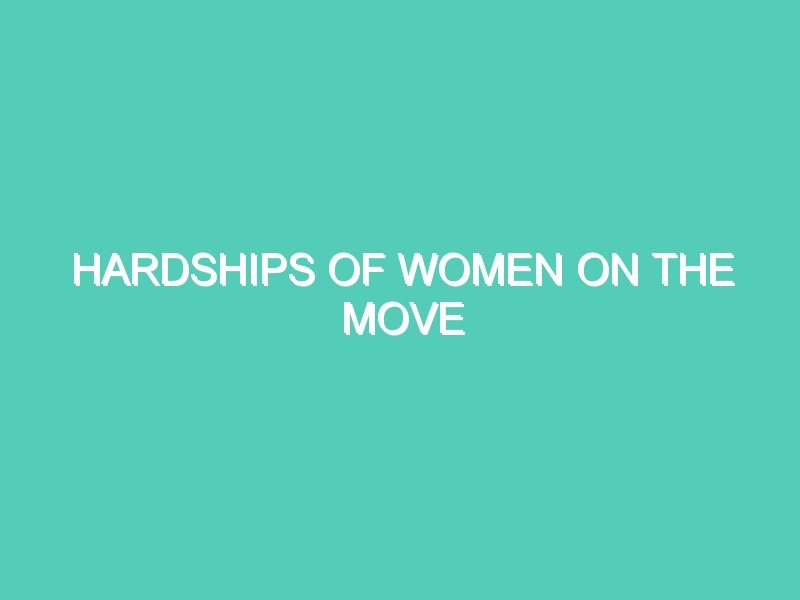INTRODUCTION
Covid-19 is the scientific term of Corona virus and it has completely shaken the countries across the globe causing them to go into lockdown and quarantine themselves since Covid-19 is a highly contagious disease. The present conditions of women and children are worst hit. These two categories amongst the whole population are currently facing most of the problems. Despite ensuring safety measures for them, their rights have been violated during Covid-19.
The ongoing pandemic has made things worse as it has impacted the labour women workers the most, depriving their access to decent work. These migrant workers specifically women, have been the backbone of our urban economy working as domestic helps, self-employed workers, home-based workers etc.
In my article, I’ll be focusing mainly on the problems and issues being faced by the informal women workers women who are not only discriminated but are distanced from their houses and are in great distress at this moment. Then, I will be discussing some ways on how the government and local NGO’s can be of great help.
Violence against women (VAW)
This pandemic has brought out several cases of violence against women and children. UN women has observed that the violation against women is “the most widespread human rights violations in the world”. During this pandemic some women have the advantage to stay home and stay away from the potential abusers while others are still facing it. There has been an increment in Domestic Violence also known as family violenceas the Human Rights Commission’s report suggests; this has happened in not only India but across the globe since during the pandemic women and children were in their homes due to lockdown. FIR’s have been submitted but due to the lockdown, police cannot detain the abuser.
Psychological Impact
Males or the sole earning head of the familycan suffer from psychological distress being causedfrom short-term loss of work or lower earnings, which can lead to violent behaviour.Incidences and reports of violence against women in their own households have also increased owing to the fact since they are confined within the four walls at home with their abusive partners during lockdown, with nowhere to escape.These instances, in the long-run adversely affect the women’s psychological well-being even more than men’s.
The Economic Consequences of COVID-19 on women[i]
Women’s involvement on farms in rural areas has increased in regions where there was shortage of labour due to a decrease in the number of women migrant labourers.Many migrant women have moved back to their homes which might result in higher agricultural wages for them in the short-run. This basically means that the demand for women’s time might rise in rural areas of India. The poor women will be worst hit.
Unequal pay for equal work
Labour markets have always shown gender disparities, specifically in Indian scenario.One would expect the concept of equal pay for work of equal value for same occupation categories to apply to male and female workers. Unfortunately, this is not the case in India, where the wages in all occupations or divisions reflect gender inequality, the ILO report said.[ii]
Women are going to be the ones who are going to be more harshly impacted when the employer will take the advantage of lockdown and will cut their salary completely. Various national as well as international organisation have after much analysis suggested that the current economic crisis will hit women the hardest, no matter which category they belong to, it will impact the female daily wage workers as well as the female managers all the same.
‘India Wage Report’ by the International Labour Organisation (ILO), published in 2018, has also noted a wide gender disparity in India’s workforce. “Female workers are paid a lower wage rate than their male counterparts in each employment category (casual and regular/salaried) and location (urban and rural), although the differences are smaller, on an average, in urban than in rural areas,” said the ILO’s.[iii]This huge gender disparity in among the labourers in India further pushes the female workers into poverty along with increasing their dependency on men.
FoodAllocation
Food security is also something, the duty of which the migrant women has to fulfil. The children and husband are all dependent on the lady to make and then provide them with the food. Despite the government distributing free food to the migrant labourers, we see that its implementation is lacking and besides that, corruption takes over and the food which is meant for the thirsty and hungry poor labourers who are walking miles, some even barefoot, gets transferred to a Minister’s house. Incidents like these put your country to shame and the government’s initiatives fail due to such reasons.
Women in the Indian Labour Market
In the last decade, India has witnessed a significant decline in the participation of its female labour force. The numbers came down from 31.2 percentile in 2011 to 2012, to merely 23.3 percentile in 2017 to 2018, according to a report by the National Sample Survey Office. The lockdown has disproportionately impacted these women workers who were working with no secure contracts, no regularly paid work as domestic helps, care workers, etc. Due to the fact that most of these workers have been excluded from the social insurance schemes, the loss of their livelihood during the lockdown period haspushed them into poverty making their lives miserable.
Menstrual Hygiene Management
It’s literally a shame to think that the migrant women have to bleedin extremely unhygienic conditions which can prove to be fatal for their health. Menstrual hygiene management (MHM) is not at all given priority during crises like the current one. Most women tend to use alternative and unsafe measures like soil, ashes, rug or old clothes to deal with menstruation when they not don’t have access to proper sanitary napkins.
No access to menstrual hygiene is the fifth biggest killer of women in the world[iv] and is a leading cause of urinary and vaginal infections, also including cervical cancer. Bad MHM can even lead to a variety of other diseases which are ignored due to many factors prevailing in the rural areas like the stigmatisation of menstrual health, negligence from healthcare in rural areas, and misdiagnosis.Women and girls tend to keep their menstrual items longer than usual, or have no option but to adopt unhygienic substitutes such as ashes, soil, old cloth or rug.
Inaccessible Reproductive Healthcare
Despite taking steps in thefew past decades towardsdecreasing maternal mortality, India still constitutes one-fifth of all maternal deaths.This rate is more than all our neighbouring countries, at 45,000 deaths in 2015 according to World Bank reports. India’s Maternal Mortality Rate (MMR) was 174 per 1 million live births in 2015.[v]Women who give birth in proper hospitals usually have a better atmosphere where they can deliver freely as compared to women who have to give birth at home. Fever as well as Sepsis are top causes of maternal mortality in India, and can be further related to multiple illnesses.
International Labour Standards During Crisis
The International Labour Organisation (ILO) has always ensured, maintained and rather developed a system of international labour standards for the promotion of decent work of workers along with their well-being.‘The ILO Monitor: COVID-19 and the World of Work’ on 7 April 2020 estimated that in India, 400 million workers in the informal economy are at the risk of falling deeper into poverty during the crisis. Back in the year 2017, the ILO had stressed on the importance for us to respect human rights when the need arises to respond to a crisis. ILO also charted out a strategic approach which included among others enhanced coverage for social protection of workers as well as ensuring to them a basic income as a security if they were to lose their jobs, in that case.
How Can Labour Reforms Help?
Just a few months ago, the Ministry of Labour and Employment had carried out certain labour reforms for the purpose of simplifying the provisions of 44 labour legislations into four different codes.A question which now arises here is that how are these reforms in any way going to help the Indian migrant workers and specifically the women migrant workers?
The Occupational Safety, Health and Working Conditions Code, 2019 seeks to regulate health and safety conditions of workers in establishments with 10 or more workers.[vi]So what happens is that it has to leave behind many migrant workers, specially the domestic helps, home-based workers, along with self-employed women workers, whose employment doesn’t fall within its purview.
This code indeed has immense potential for the protection of the rights of the migrant workers, but still there are manyloopholes that need to be taken care of. For instance, the chapter which was on migrant workers was merged with the chapter meant for contract workers.
The Standing Committee on Labour had presented its report to the government on 11th February 2020 and informed them about the loopholes in the code, including the need for making a distinct chapter on migrant workers.With respect to women workers also, we find that the code does not include any special provisions. Regardless of all the above-mentioned gaps, the biggest testlies in the implementation of this code with limiteddata being available on migrant workers.
It’s high time that this code gets revised, specifically in the context of the pandemic as well asthe impact it has on women migrant workers.Furthermore, the code also needs to be a little more gender sensitive i.e. to say that it needs to protect the rights which women migrant workers possess who are facing hardships like loss of income, being away from their homes, psychological stress, and are harshly affected by the crisis.
What can governments do?
The need of the hour is to recognise and provide reproductive health services, as well as other healthcareas essential services and to make it easily accessiblefor the workers should be a part on which the State should respond swiftly. Besides this, maternal healthcare as discussed above also requires access to good amount of nutrition i.e. healthy food which can be done through schemes like ‘Janani Suraksha Yojana’ or already existing ‘Janani Shishu Suraksha Karyakaram’ among others.[vii]Menstrual health of young girls should be made a priority by the government and a gendered view should be adopted in dealing with such matters at the time of prevailing crisis.
Transport facilities being segregated on the basis of gender can also prove to have beneficial implications for migrant women. While working for a larger cause, that of making the public transport much more safe, transitional steps including women’sonly transport for the migrant women who are willing to return may be considered.[viii]
Policy recommendations[ix] are based on the clear fact that the policymakers need to view this pandemic through a gendered lens and should incorporate a gender analysis while drafting policies for the on-going crisis.If one is able to understand the impact which lockdown is having on women and girls, then itwill lead to direct results of development of all the policy measures being designed and then implementing them effectively. Likewise, while we assess the gender related aspects of minimising disturbances and maintain supply chains for essential items, the only possible outcomeis that it will reap better results for all, whether men or women or any other community for that matter.
CONCLUSION There is absolutely no doubt about the fact that there still exist deep-seated inequalities which are based on sexuality and gender and in times like these, they tend to become more evident.We tried to analyse the different aspects of how the women have been impacted through this lockdown and seeing their ordeal, we can only suggest the government to take the necessary steps required for their upliftment and help them in any way possible. The NGO’s can also help by extending their arms and providing the migrant workers with the essential items. Let’s all come together and help each other to get out of this pandemic safely.
Article Written By- Gauri Choubay
Law Student– DME School of Law
(HRDI Work From Home Internship)
[i]https://www.theigc.org/blog/covid-19-and-the-impact-on-women/
[ii]https://www.thehindubusinessline.com/news/why-the-economic-devastation-caused-by-covid-will-hit-women-workers-hardest/article31421951.ece
[iii]Ibid.
[iv]https://www.indiatoday.in/education-today/gk-current-affairs/story/no-access-to-menstrual-hygiene-fifth-biggest-killer-of-women-in-the-world-1552450-2019-06-20
[v]https://niti.gov.in/content/maternal-mortality-ratio-mmr-100000-live-births
[vi]https://www.thequint.com/voices/women/labour-reforms-help-women-migrant-workers-during-covid-19
[vii]https://www.thequint.com/voices/opinion/migrant-women-stranded-covid-lockdown-menstruation-unsafe-pregnancy-delivery-essential-services
[viii]https://indianexpress.com/article/opinion/why-dont-we-see-the-women-the-untold-story-of-covid-19-migration-6378557/
[ix]Supra, 2



